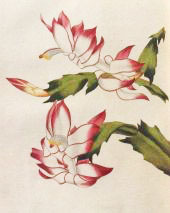Cherished Christmas Cactus
By Audrey Stallsmith

All during the Christmas rush
I waited for the thing to come alive. . .
By New Year's
I vowed to be happy
with just stems. . .
"The Christmas Cactus" by Liz Rosenberg
Many of us have sentimental attachments to our Christmas cacti, which--as they are so easy to grow--tend to be handed down in families. Sometimes becoming quite huge in the process. That's probably why cacti stand for "endurance" in the Language of Flowers.
I have a very small one which was given to me by an aunt just before she had to go into a nursing home. Though it probably should be moved into a bigger container, I've left it in the aged pink and green ceramic pot that she used, to remind me of her.
The original Christmas cacti, once known as zygocactus and now as schlumbergera, was discovered--growing on trees in the Brazilian rain forest--by plant hunter Alan Cunningham around 1816. It is an epiphyte, rather than a parasite, meaning that it doesn't actually suck the life out of the timber to which it attaches!
As this hanging about in trees is similar to the growth habit of orchids, schlumbergera was originally nicknamed "orchid cactus." But that title is generally applied to epiphyllums these days. As schlumbergera blooms during the "shortest" days of the year, it was known as Mayflower in Brazil--since the seasons are reversed in the southern hemisphere.
Cunningham, who worked for Kew gardens, probably carried at least a couple types back to England. And the Christmas cactus so popular with our grandmothers is thought to have resulted from a cross between truncata (a late fall type also known as Thanksgiving cactus) and russelliana (a mid-winter type) to produce buckleyi, which should bloom near Christmas.
That usually only happens, however, if the plant experiences consistently shorter days for several weeks before the holiday. Otherwise it is inclined to bloom late or not at all.
Botanist Charles Lemaire eventually named the genus after a fellow cacti collector, Frederic Schlumberger, who had nothing to do with the plant's discovery. If life were fair, it should actually have been called cunninghama!
I also have a larger yellow "Christmas cactus," which has no emotional baggage, having come from the local Wal-Mart. It surprised me by blooming during the fall. But I've learned since that most of the modern yellows are derived from Schlumbergera orssichiana, which wasn't discovered until 1978. And this broader-leafed newcomer generally blooms earlier than the other types.
The species varieties of schlumbergera, in fact, cover a pretty wide flowering period, beginning with orssichiana in August or September and ending in March or April with opuntiodies. So the term "Christmas cactus" is probably a trifle inaccurate. Applying, as it does, to only one member of the clan.
It can be hard to find the "old-fashioned" type in stores these days too. Most Christmas cacti sold now seem to sport the new broader leaves. But there's almost sure to be someone in your family who will allow you to take a cutting from their heirloom.
If you have trouble getting your Christmas cactus to bloom, try putting it outside under a tree during the summer. Then, when you bring it indoors in the fall, set it on the windowsill in a room that isn't used during the evening. (And is well away from any streetlights, of course!) That way, it will only get illumination during the daylight hours. And the long nights should be its cue to bloom.
Perhaps another reason we love our Christmas cacti so much is that they provide color and warmth during the darkest time of the year. Much as our family members provide the same during the darkest times of our lives. And we know they too will "hang in there" with us for the long haul.
Schlumbergera truncata Spectabile image is from Portfeuille des Horticulteurs.








